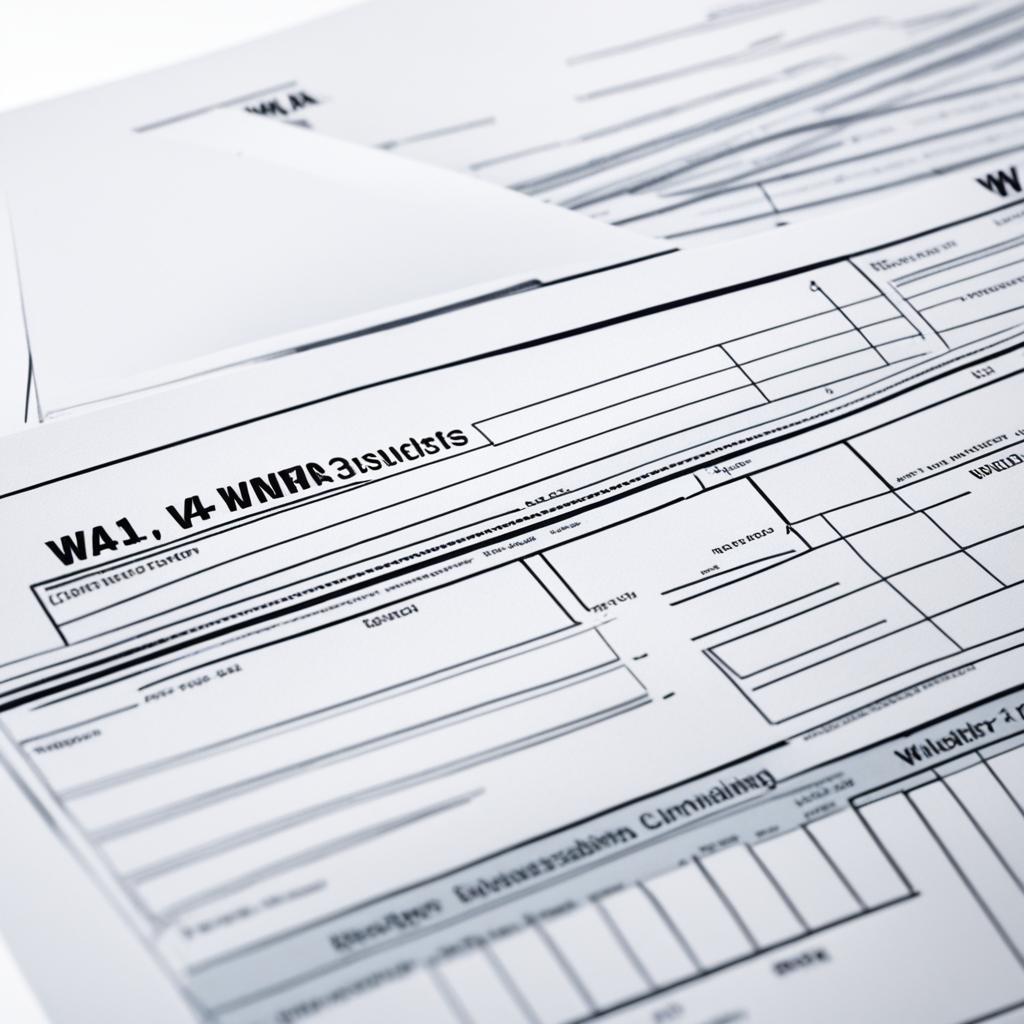Welcome to our comprehensive guide on how to fill out a W-4 form for dummies. Tax withholding may seem like a complex task, but with the right instructions and guidance, it can be a straightforward process. Whether you’re a new employee or looking to make adjustments to your tax withholding, this guide will provide you with step-by-step instructions and valuable tips. Say goodbye to confusion and hello to accurate tax withholding!
Key Takeaways:
- Understanding how to fill out a W-4 form is crucial for accurate tax withholding and avoiding surprises at tax time.
- The W-4 form is used by employers to calculate the amount of tax to withhold from your paycheck throughout the year.
- Filling out a W-4 form is a relatively straightforward process that can be simplified with step-by-step instructions.
- It is important to stay updated on any changes to the W-4 form to ensure accurate tax withholding.
- Reviewing and updating your W-4 form annually or when significant life changes occur can help optimize your tax withholding.
What is a W-4 Form?
A W-4 form, formally known as an Employee’s Withholding Certificate, is a tax document that employees fill out and give to their employers. It plays a crucial role in determining how much federal income tax is withheld from an employee’s paycheck. By understanding the purpose and components of the W-4 form, you can accurately determine your tax withholding and ensure compliance with tax laws.
When filling out a W-4 form, employees provide information such as their tax filing status, number of dependents, and any additional withholding adjustments. This information helps employers calculate the appropriate amount of federal income tax to withhold from each paycheck.
The W-4 form serves as a tool for both employees and employers to ensure accurate tax withholding. Employees can use it to detail their tax situation and provide necessary information, while employers rely on the form to determine the appropriate tax withholding.
Understanding the purpose and function of the W-4 form is essential for managing your tax obligations effectively. By correctly completing this form, you can ensure that the correct amount of federal income tax is withheld from your paycheck throughout the year, preventing surprises at tax time.
How to Fill Out a W-4 Form
Filling out a W-4 form may seem daunting at first, but it is actually a relatively straightforward process. To help you navigate through it with ease, here is a step-by-step guide:
- Step 1: Provide your basic information. Start by entering your full name, address, and Social Security number. This information ensures that your employer can accurately identify you for tax purposes.
- Step 2: Choose your filing status. Indicate whether you are single, married, or have any other filing status such as head of household or qualifying widow(er) with a dependent child. Selecting the correct filing status is crucial for determining the appropriate tax rates and deductions.
- Step 3: Claim your allowances. This section allows you to specify the number of dependents you have, as well as any other tax deductions or credits you are eligible for. The more allowances you claim, the less tax will be withheld from your paycheck.
- Step 4: Make additional withholding adjustments if necessary. If you have any additional income that is not subject to withholding, such as self-employment income or investment earnings, you may need to adjust your withholding to avoid underpayment penalties. Consult the IRS withholding calculator or a tax professional for guidance.
- Step 5: Sign and date the form. Once you have completed all the necessary sections, sign and date the W-4 form to certify that the information you provided is accurate.
Remember, it is important to review and update your W-4 form whenever there are significant changes in your life that may impact your tax withholding. This includes getting married, having children, or taking on a second job. By keeping your W-4 form up to date, you can ensure that you are effectively managing your tax obligations.
“Filling out a W-4 form is a breeze when you break it down into simple steps. By providing accurate information and regularly reviewing your form, you can efficiently manage your tax withholding and avoid any surprises come tax time.”
Now that you have a clear understanding of how to fill out a W-4 form, you can confidently navigate this process and ensure accurate tax withholding. Empower yourself by taking control of your tax obligations and optimizing your financial well-being.
Changes to the W-4 Form in 2024
The W-4 form undergoes changes periodically, and it is important to stay updated on the latest version. The recent changes to the W-4 form aim to make it more transparent and accurate for employees and employers. In 2024, the W-4 form was updated to eliminate personal exemptions and instead focus on specific information related to dependents and other factors that affect tax withholding. By being aware of the changes to the W-4 form, you can ensure that you are filling it out correctly and optimizing your tax withholding.
Summary of Changes in the 2024 W-4 Form
The changes in the 2024 W-4 form were implemented to simplify the process of determining tax withholding. Here are the key changes:
- Elimination of personal exemptions: Unlike previous versions of the form, the 2024 W-4 form no longer requires individuals to claim personal exemptions.
- Focus on dependents and credits: The new W-4 form emphasizes providing accurate information regarding dependents and eligibility for tax credits, such as the Child Tax Credit or the Credit for Other Dependents.
- Adjustments for multiple jobs: The revised form includes new instructions and worksheets to help individuals with multiple jobs calculate the appropriate withholding amount.
- Optional other income: The 2024 W-4 form provides an optional section for individuals to report other sources of income that are not subject to withholding, such as interest or dividends.
By understanding these changes and carefully completing the 2024 W-4 form, you can ensure that your tax withholding accurately reflects your current tax situation. This can help you avoid any under or overpayment of taxes and ensure a smoother tax filing process.
Comparison of 2024 W-4 Form vs. Previous Versions
| Version | Changes |
|---|---|
| 2024 | Elimination of personal exemptions, emphasis on dependents and tax credits |
| [year-1] | Partial elimination of personal exemptions |
| [year-2] | Introduction of personal exemptions |
The table above provides a comparison between the 2024 W-4 form and the previous versions. It highlights the key changes that have been implemented over the years, allowing you to see the evolution of the form and how it affects tax withholding.
How to Adjust a W-4 Form
Adjusting a W-4 form allows you to make changes to your tax withholding based on your individual circumstances. Whether you want to increase or decrease your withholding, here are some easy w4 filing tips to help you:
- Determine your desired withholding amount: Consider your financial goals and tax obligations to decide if you need to adjust your withholding. If you want more money in your paycheck, you can increase your withholding allowances. On the other hand, if you prefer a larger tax refund, you can decrease your allowances.
- Update your personal information: Review your personal details, such as your name, address, and Social Security number, to ensure they are accurate and up to date. Any changes in this information should be reflected on your W-4 form.
- Consider additional income: If you have other sources of income, such as a side gig or rental property, factor in that income when determining your withholding allowances. You may need to make additional adjustments to account for this extra income.
- Adjust for dependents: If you have dependents, you may be eligible for certain tax credits and deductions. To ensure that you receive the appropriate tax benefits, carefully consider the number of dependents you have when adjusting your W-4 form.
- Review your filing status: Your filing status can also impact your tax withholding. If your marital status has changed or you have experienced other life events that affect your filing status, update this information on your W-4 form.
- Use the IRS Tax Withholding Estimator: The IRS provides a helpful tool called the Tax Withholding Estimator to help you determine the appropriate withholding allowances. This online calculator takes into account various factors and provides personalized recommendations for adjusting your W-4 form.
By following these w4 form guide tips, you can ensure that your tax withholding aligns with your financial situation and goals. Don’t hesitate to seek additional guidance from a tax professional if you have complex tax circumstances or need further assistance.
Do I Have to Update My W-4 Every Year?
Navigating the complexities of tax withholding can be a challenge, especially for beginners. One common question that arises is whether updating the W-4 form is necessary on an annual basis. While the answer is not a straightforward yes or no, it is generally recommended to review and update your W-4 form whenever there are significant life changes or adjustments to your tax situation.
Life events such as getting married, having children, or taking on a second job can impact your tax liability and withholding requirements. By regularly reviewing your W-4 form, you can ensure that your tax withholding aligns with your current financial situation, preventing any surprises at tax time.
Life changes, such as getting married or having a child, can significantly impact your tax situation. By updating your W-4 form, you can ensure that your tax withholding accurately reflects these changes and prevents any under or overpayment of taxes.
If you’re unsure whether you need to update your W-4 form, the IRS offers a helpful tool called the Tax Withholding Estimator. This online resource allows you to input your current financial information and provides personalized recommendations on whether you need to adjust your withholding. It takes into account factors such as your filing status, dependents, and any additional income sources.
Keeping your W-4 form up to date ensures that you are meeting your tax obligations throughout the year. By proactively managing your withholding, you can avoid owing a significant amount at tax time or receiving an unexpectedly large refund. Consulting the IRS and regularly reviewing your W-4 form can help you navigate the complexities of tax withholding and ensure compliance with tax laws.
Key Takeaways:
- Reviewing and updating your W-4 form is not required every year but is a good practice to ensure accurate tax withholding.
- Life changes, such as getting married, having children, or taking on a second job, can impact your tax liability and may necessitate an update to your W-4 form.
- The IRS provides a Tax Withholding Estimator tool to help taxpayers determine if they need to make adjustments to their withholding.
- By staying current with your W-4 form, you can avoid surprises at tax time and ensure compliance with tax laws.
What is the W-4 Form for 2024?
The W-4 form for 2024 is the most current version released by the IRS for employees to fill out and provide to their employers. It includes updated instructions and fields to accurately determine tax withholding. The changes in the W-4 form for 2024 are aimed at simplifying the process and improving transparency for employees and employers. By using the correct W-4 form for 2024, you can ensure that you are providing accurate information for tax withholding purposes.
Key Changes in the W-4 Form for 2024
The W-4 form for 2024 introduces several key changes that simplify the process of determining tax withholding. These changes include:
- Elimination of personal exemptions: The W-4 form no longer uses personal exemptions to calculate withholding. Instead, it focuses on factors such as filing status, number of dependents, and other income adjustments.
- New checkbox for multiple jobs or working spouses: If you have multiple jobs or you and your spouse both work, the W-4 form provides a checkbox to indicate this situation. By checking this box, you can ensure that the correct amount of tax is withheld.
- Enhanced Child Tax Credit and Credit for Other Dependents: The redesigned W-4 form incorporates the changes made to these tax credits. It allows you to provide information about your dependents to determine the appropriate tax withholding.
By understanding these changes and using the updated W-4 form for 2024, you can accurately calculate your tax withholding and avoid overpaying or underpaying your taxes.
Example W-4 Form for 2024

| Field | Description |
|---|---|
| 1. Personal Information | Provide your name, address, Social Security Number, and filing status. |
| 2. Multiple Jobs or Spouse Works | Check this box if you have multiple jobs or your spouse also works. |
| 3. Claim Dependents | Indicate the number of dependents you have. |
| 4. Other Adjustments | Provide information about other income adjustments, such as deductions and credits. |
| 5. Sign and Date | Sign and date the form to certify its accuracy. |
Completing the W-4 form accurately ensures that your tax withholding aligns with your financial circumstances. By staying informed about the changes in the W-4 form for 2024 and using the correct version, you can have peace of mind knowing that your tax withholding is optimized.
How to Find the 2024 W-4 Form
Filing your taxes correctly starts with having the right forms. To find the 2024 W-4 form, you can visit the official website of the Internal Revenue Service (IRS). The IRS provides a user-friendly platform where you can easily access and download the W-4 form in PDF format. Simply navigate to the IRS website and search for the 2024 W-4 form to locate the official document.
If you prefer to fill out the form manually, you can print it and complete it by hand. Make sure to use a printer with good quality to ensure the form is legible and meet your needs.
The IRS also recognizes the diverse linguistic needs of taxpayers and provides resources in multiple languages. If you require translation assistance, the IRS offers the 2024 W-4 form in languages such as Chinese, Korean, Russian, Spanish, and Vietnamese. These resources are readily available on the IRS website to ensure accessibility for all individuals.
Furthermore, some employers provide the option to fill out the W-4 form electronically through their payroll system. This convenient method allows you to complete the form online, saving you time and effort.
By accessing the 2024 W-4 form through the IRS website or your employer’s electronic system, you can confidently proceed with accurate tax withholding.
Why Withholding Matters
Withholding matters because it directly affects the amount of money deducted from your paycheck for taxes. The withholding amount is determined by the information you provide on your W-4 form. By adjusting your withholding correctly, you can ensure that you are paying the right amount of taxes throughout the year. This can prevent you from owing a large sum at tax time or receiving an unexpectedly large refund. Understanding the significance of withholding and accurately completing your W-4 form is crucial for managing your tax obligations.
Juggling Multiple Jobs? Here’s How to Handle It
If you have the challenge of juggling multiple jobs, it’s crucial to effectively manage your tax withholding to avoid underpayment or overpayment of taxes. Here are some tips to help you handle multiple jobs:
- Understand your tax obligations: Take the time to understand how having multiple jobs impacts your tax situation. Each job will require you to complete a separate W-4 form, and the total income from all jobs will determine your tax liability.
- Consider your total income: Calculate your total income from all jobs to determine your tax bracket. Understanding your tax bracket will help you estimate how much tax should be withheld from each paycheck.
- Review your W-4 forms: Ensure that you accurately complete a W-4 form for each job you have. Take into account your total income, deductions, and credits to determine the appropriate withholding allowances for each job.
- Use the IRS withholding calculator: The IRS provides a useful online tool called the Tax Withholding Estimator, which can help you calculate the correct amount of tax to withhold. It takes into consideration your total income and allows you to factor in any credits or deductions to optimize your withholding.
- Monitor your overall tax liability: Throughout the year, keep an eye on your total tax liability. If you find that you are underpaying or overpaying taxes, you may need to adjust your withholding by completing new W-4 forms for one or more of your jobs.
By following these tips and staying attentive to your tax obligations, you can effectively navigate the complexities of managing multiple jobs without encountering tax-related issues.

The Difference Between a W-4 and a W-2 Form
When it comes to taxes, two key forms to be familiar with are the W-4 and W-2 forms. While they both play a role in the tax process, they serve different purposes and provide distinct information.
The W-4 form is completed by employees and submitted to their employers to determine the amount of tax to withhold from their paycheck. This form includes details such as filing status, number of dependents, and additional withholding adjustments. By accurately filling out the W-4 form, employees ensure that the appropriate amount of tax is withheld from their wages throughout the year.
On the other hand, the W-2 form is provided to employees by their employers at the end of the year. It summarizes the employee’s total earnings and the amount of taxes withheld from their paychecks throughout the year. The W-2 form is essential for filing income taxes as it provides the necessary information to report earnings and calculate the tax liability.
In summary, the W-4 form focuses on tax withholding, allowing employees to specify their tax preferences, while the W-2 form provides a comprehensive record of an employee’s income and tax withholding for the year.
| Form | Purpose | Completed By |
|---|---|---|
| W-4 Form | Tax withholding | Employees |
| W-2 Form | Income reporting and tax calculation | Employers |
Your Filing Status and Its Impact on the W-4 Form
Your filing status is a crucial factor in determining your tax liability and withholding. It is essential to accurately indicate your filing status when filling out the W-4 form to ensure proper tax withholding. The W-4 form offers several filing statuses, including single, married filing jointly, married filing separately, head of household, or qualifying widow(er) with a dependent child. Each filing status has distinct tax rates and deductions that directly impact your tax withholding. By selecting the correct filing status on the W-4 form, you can ensure that your withholding aligns with your unique tax situation.
When determining your filing status, it is important to consider various factors such as your marital status, dependents, and household arrangements. Each filing status has specific criteria that must be met to qualify, which can significantly affect your tax liability. Understanding the implications of each filing status can help you make an informed decision when completing the W-4 form.
| Filing Status | Description |
|---|---|
| Single | An individual who is not married or legally separated. |
| Married Filing Jointly | A married couple filing a joint tax return. |
| Married Filing Separately | A married individual choosing to file a separate tax return from their spouse. |
| Head of Household | An unmarried individual who pays more than half the cost of maintaining a home for a qualifying person. |
| Qualifying Widow(er) with Dependent Child | A widow(er) who can claim the benefits of a married taxpayer for two years following the death of their spouse, with a dependent child. |
Choosing the appropriate filing status ensures that your tax withholding aligns with your specific circumstances, preventing unexpected tax liabilities or overpayments. It is important to review your filing status regularly to ensure it accurately reflects your current situation. Life changes such as marriage, divorce, or the birth of a child can impact your filing status, warranting updates to your W-4 form.
By understanding the significance of your filing status and accurately completing the W-4 form, you can successfully manage your tax withholding and meet your tax obligations. It is advisable to consult with a tax professional or refer to the IRS guidelines to ensure that you choose the correct filing status based on your individual circumstances.
How Do Dependents Affect Your W-4 Form?
Dependents play a crucial role in determining your tax withholding and the information you provide on your W-4 form. Understanding how dependents affect your tax situation is essential for optimizing your tax withholding and maximizing your tax benefits.
When you have dependents, you may qualify for various tax credits and deductions, such as the Child Tax Credit or the Dependent Care Credit. These credits can significantly lower your tax liability and potentially lead to lower tax withholding.
When filling out your W-4 form, it is important to accurately indicate the number of dependents you have. This information helps determine the appropriate tax benefits that should be applied to your withholding. Providing incorrect or incomplete information may result in overpaying or underpaying your taxes.
It is crucial to understand the rules and eligibility criteria surrounding dependents. For example, to claim a dependent on your W-4 form, the dependent must meet certain criteria, such as being a qualifying child or qualifying relative. To fully optimize your tax withholding, familiarize yourself with the IRS guidelines or consult a tax professional.
By correctly accounting for your dependents on your W-4 form, you can ensure that your tax withholding aligns with your tax situation, potentially leading to a more accurate withholding throughout the year.
| Dependent | Impact |
|---|---|
| Child | Qualify for Child Tax Credit and potentially reduce tax liability. |
| Qualified Relative | May qualify for the Dependent Care Credit. |
Conclusion
Filling out a W-4 form may seem intimidating at first, but with the right guidance, it can be a straightforward process. By understanding the purpose of the W-4 form and following step-by-step instructions, you can ensure accurate tax withholding and avoid any surprises at tax time.
Remember to review and update your W-4 form as needed, especially when there are significant life changes that may affect your tax liability. By taking control of your tax withholding through the W-4 form, you can have peace of mind knowing that your tax obligations are being managed effectively.
So, whether you’re a seasoned professional or a beginner looking for a W-4 form guide, following the step-by-step W-4 instructions will help you navigate the process with ease. Don’t hesitate to seek further assistance or consult the IRS website for additional resources and tools to simplify your W-4 form completion.
FAQ
What is a W-4 Form?
How to Fill Out a W-4 Form?
What are the changes to the W-4 Form in 2024?
How to adjust a W-4 Form?
Do I have to update my W-4 every year?
What is the W-4 Form for 2024?
How to find the 2024 W-4 Form?
Why does withholding matter?
How to handle multiple jobs and W-4 forms?
What is the difference between a W-4 and a W-2 form?
How does my filing status impact the W-4 form?
How do dependents affect my W-4 form?
Conclusion
Source Links
- https://www.taxfyle.com/blog/2023-w-4-form-for-dummies
- https://www.investopedia.com/articles/personal-finance/081214/filling-out-your-w4-form.asp
- https://www.nerdwallet.com/article/taxes/how-to-fill-out-form-w4-guide
Money posts:
 Welcome to W-4 Form: What It Is & How to Fill It Out!
Welcome to W-4 Form: What It Is & How to Fill It Out!
 How to Do Taxes: Simplified for Beginners (2024)
How to Do Taxes: Simplified for Beginners (2024)
 Best Tax Software: File with Confidence (2024)
Best Tax Software: File with Confidence (2024)
 Child Tax Credit Update Today: What You Must Know (2024)
Child Tax Credit Update Today: What You Must Know (2024)
 Do I Have to Pay Taxes on My Checking Account?
Do I Have to Pay Taxes on My Checking Account?
 DoorDash Taxes Made Easy (2024 Tax Guide)
DoorDash Taxes Made Easy (2024 Tax Guide)
 How to Handle Taxes For Your Side Hustle (2024)
How to Handle Taxes For Your Side Hustle (2024)
 Top Considerations Before You Hire A CPA
Top Considerations Before You Hire A CPA

